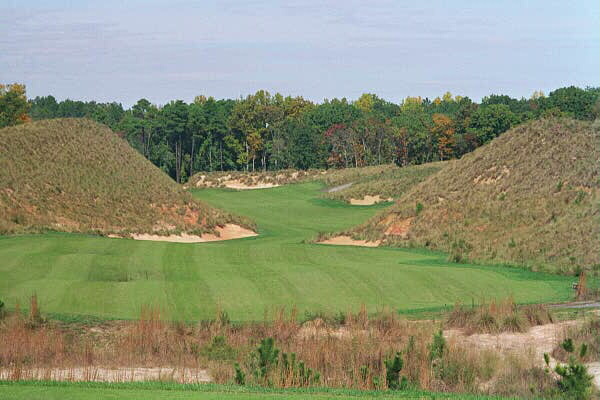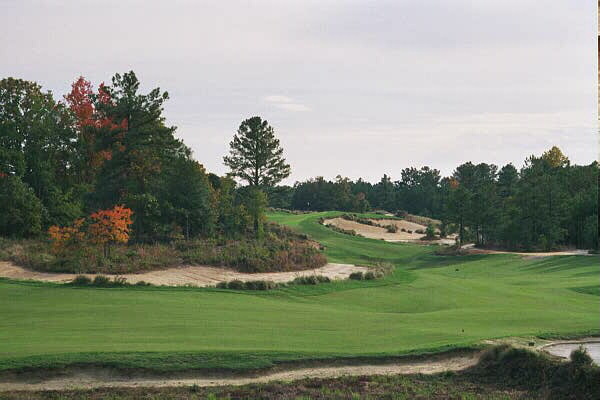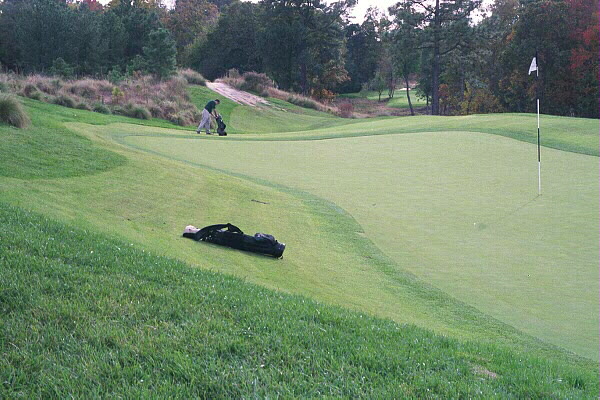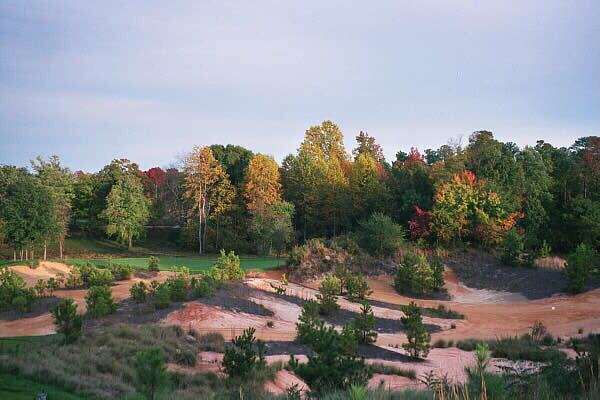Feature Interview with Joe Gay
October, 2002
Joe Gay was born and raised in Sanford N.C. and played on the 1982 High School State Championship from Lee County Senior High. He went on to gain a business degree at N.C. State in 1988. While at State, Gay played on the golf team where he received academic ACC status in 1985 and 1986. In 1987 he was placed on the Academic All-American golf team. In 1988, Gay enjoyed his most successful year both on and off the links, capturing Academic All-American status as well as N.C. States MVP, All-ACC and All-American honors.
In 1988 Joe relocated to Pinehurst, N.C. and became the assistant Pro at the Club at Longleaf. After two years he was named the first Head Golf Professional at the Dan Maples designed Sound Golf Links on the Albemarle Sound. Joe moved on to Southern Wayne C.C. as the General Manager before coming back home to Sanford in 1998. Joe came on board July 1st 1998 as the Director of Golf at Tobacco Golf Club.
1. You grew up in the area. Describe the site with which Mike Strantz had to work.
Tobacco Road is built in the northern-most point of the Sandhills. We are in a sandy soil but only four miles up the road is a very red clay-based soil structure that has made the town of Sanford famous for its brick production. The site has had a variety of uses over the years: a peach orchard, pasture land for dairy cows, a tobacco farm and most recently in the 1950s through the 1980s a quarry to provide sand for an asphalt plant across the street.
2. In what capacity and when in the development of the course did you become involved?
I came aboard five months before the course was open. My initial focus was to get the business operational. I had little to do with the development other than taking some of the ideas of the owners and Mike and tying them into a consistent theme and marketing plan. My wife, I am proud to say, decorated the clubhouse (both of them, that’s another story). My primary role now is to spread the word and keep the customers happy.
3. What impressed you with how Strantz went about his job?
His passion for producing the best golf possible. My first day on the job I arrived at 7:30am, and Mike and his crew plus our maintenance crew had already been working for an hour and a half. When I got ready to leave at about 6:00pm, they were still going at it. I am told that they had that attitude from day one. Mike’s attention to detail was tremendous. Every plant, fairway line, green shape, bunker, cart path routing, you name it, was tediously thought out and directed by Mike.
4. What role did Forrest Fezler play at Tobacco Road?
I think Forrest brings a great resource of being a former tour player and being a club pro for Mike to use. Mike values his opinion on many fronts. Mike used Forrest extensively when it came to the forced carries and the fairness of landing areas. Forrest hit many tee shots with a variety of clubs from proposed tee boxes to see if what Mike had on paper worked (holes #1,#4 as far as getting past the tree line to go for the green,#13,#18 come to mind).
5. How many cu. yards of dirt were moved during construction?
A little over 500,000 cubic yards of dirt was moved to build Tobacco Road; however, the Lee Paving Company excavated over one million cubic yards of material from the site from the 50’s to the late 80’s. Mike used many of the features left over the years from the paving company and incorporated them into the design.
6. Once the routing was in place and it became evident that the course would max out around 6,500 yards, were you worried from a marketing point of view that the course wouldn’t be viewed of ‘championship’ length?
Yes, I was concerned. I think many golfers are still influenced by the courses built in the 60’s through the 80’s where unless you were 7000+, you were not legit. Many older designs were adding tees and fudging scorecards just to get to that magical 7000 yard mark. We still have to convince some first time players that there is more to challenge them than just length, especially when they bring that 16 handicap to our ‘championship’ tees.
7. How many acres of prepared surfaces do you maintain?
I maintain the acreage between the front door to the counter! Seriously, I have nothing to do with the maintenance of the course, to the golfing public’s benefit. Perry Payne and Morgan Stephenson and their staff maintain about 45 acres of fairway, 15 acres of fescue rough, 3 acres of greens and 3 acres of tees.
8. How are the sandy areas on such holes as 4, 5, and 6 maintained?
Mike’s intention is to leave them natural. We have to ‘tweak’ those areas from time to time to keep that look especially after big rains. That ‘tweaking’ has lessened and evolved over time for a number of reasons. 1. Areas that are out of play and/or are not integral to the design of the course, we have just added ground cover or ‘love grass’ to stop erosion (in front of #1 and #12 tee, water used to rush down and bring sediment from #9 tee box toward #8 green, down several cart paths). 2. Areas that washed initially that were in play or were important to the design were looked at and drainage was added or Mike came in and diverted water to other areas (#1 at the second pinch point, new ‘lows’ were created with drains, #16 the mini ravine eroded badly and that look was critical to that hole so Mike diverted water away from that feature) 3. Quite frankly, the maintenance staff has found better and more efficient ways of dealing with the minor washes that don’t apply to #1 and #2 above (which area to attack with a sand pro and what area to use a tractor and drag attachment to groom). Having said all of that, if the area is not eroded or has not changed with taller growing plants to inhibit sight lines, Mike does not want it touched anyway.

Tobacco Road is presented in an appealingly natural and rugged state.
9.What is thepercentage of the maintenance budget to revenue?
Our maintenance budget is currently running at 27% of total revenue.
10. Plenty of daily-fee courses exceed that percentage. Why do you think people assume that the course is much more costly to maintain than is actually the case?
The same reason I assumed it at first, it is so different. People see severe slopes, they see expense. They see waste area, more expense. They see wide landing areas mowed with small triplex mowers, they see expense. The up-side for us is that on most of the severe slopes we have ‘love’ grass for erosion control (no hand mowing with fly-mows). The waste area we prep as needed and even though we have large fairways, our total irrigated acreage is much less than most clubs have to maintain. We also have a rough and ‘knarly’ look to our course which cuts down on expense. I think it would look out of place for us to edge our cart paths and have pretty landscaped flower beds. My best friend growing up has been a Superintendent at several clubs, and one in particular edges their cement cart paths. He use to complain that it took two guys, one on the edger and one with a flat headed shovel, two weeks to go around the 27 holes on both sides of the path in the summer. When they were done, they had to start back from the beginning. At the same club they had a par 5 that a 30ft grassed embankment fronted the green, they would attach ropes to fly-mows and lower them up and down the embankment until it was mowed. I know those are extreme examples and all courses have their maintenance challenges, and we certainly have ours. But, we feel good about what Mike left us. And more importantly, our superintendent feels good about it.
11. Which three design features illict the most reponses from first time players?
#1 Blind shots — Most people are uncomfortable and intimidated by them, but usually get over it when they realize the generous landing areas they face on the other side (it’s the tee shots that are not blind that you need to worry about out here!)
#2 Sandy ‘waste’ or natural areas — Most create intimidation and are found as forced carries off the tee.

If the golfer successfully makes this carry over the sandy scrub at the 4th, he is rewarded with an eagle putt.
#3 Big sloping greens — Because the greens are ‘bowl’ shaped, players get more favorable caroms from this feature that create smiles.
12. Is there anything that you would like to see Mike Strantz consider changing with today’s design?
I thought I did. The reason I say that is because I went to a PGA seminar about two years ago and one of the featured speakers was an architect whose designs I enjoy. He said that he never started a course with a reachable par 5 in the first four holes and his first hole is usually a medium range par four that is open in order to give the golfer a good, fast start. I was all over that because we have two reachable par 5’s in the first four holes and the first one is quite demanding and intimidating. He said he tried to elevate all his tees to eliminate blind shots. I was thinking, ‘whew, wouldn’t that be nice.’ He tried to avoid having holes going east-west because of sun being in the golfers eyes. He also would try to have a ‘signature hole’ or two late in the round so the golfer would be left with a lasting impression of the golf course. I remembered Mike commenting to me that he disliked being asked about ‘signature holes’ because he put everything he had on every hole instead of giving more effort on one or two holes and having several fillers. Mike would ask ‘would an artist paint several so-so pieces, just to have his one or two of his inspried works seem that much better?’
Although I would love to have four hour rounds, never have my golfers lose a ball, or have a cross word said about our track, the more I listened to this speaker/architect, the more I knew that a golf course can’t be all things to all people. I also know that of all the courses that my speaker/architect had designed, none would I remotely consider trading Tobacco Road for.
I think back to a statement I read in Dean Smith’s book that referred to his male alumni and Tarheel fan base. He said something like ‘there are two things our fans are experts at doing. One, cooking steaks on the grill, and two, coaching college basketball!’ Well that can apply to club pros also. We make great steaks on the grill, and we make great armchair architects.
Of the suggestions that have been mentioned to me about possible changes to the course, the one with the most merit to me is to vary the par three distances a little more. Although our par 3’s are all great, some days they seem to play all between a wedge and a 6 iron.
As with most works, they evolve over time. Didn’t Ross tinker with #2 all of his life? And whether we like it or not, Diamondhead Corp., Club Corp. and the USGA have been making changes ever since, yet it is still a masterpeice. I think Mike will tinker with Tobacco Road from time to time because he cares about it. He was the first to initiate change to our #15 green complex with the burm guarding the left side of the green. He inverted the burm and made it into a bunker/waste area to give a better site line. He has made some subtle changes to other holes that have made them all better. I hope Mike will always tinker with ‘The Road’, but our work-in-progress is pretty darn awesome.
13. You have played the course over 50 times. Is there a particular hole or feature that you didn’t appreciate at first that you have come to admire with time?
#13 That hole would drive me crazy. I would hit a good drive there and have about 200 yards in, knowing I was an idiot if I went for the green. So, I would lay up with a 7 iron and have a tough pitch of 40 to 50 yards left to a blind pin and felt like it was a lottery to get it close. I have come to realize that unless I can blow it over the trees on the drive, I need to lay up about 90 yards out as to have a full sand wedge in, so that I can see the pin and have more distance control.

The 13th green complex is tucked in a natural hollow and is a mere 16 paces deep, forcing the golfer to play a very well controlled approach.
14. The 1st hole is very dramatic with the ideal tee ball sailing between two high dunes to a wide fairway beyond. The not so ideal tee ball might end up on the side of one of the dunes whichmakes for a tough start. How have people come to view this opener after five years of play?
I think most still have to pick up their jaw off the ground when they see it for the first time. Let’s face it, it is a tough starting hole. Our players know now what to expect and they get that thrill from the very first shot off #1. From an operational standpoint, we do 10 minute teetimes so we keep from getting backed up, and we have expanded the rough further into the love grass as a bigger buffer. Having said that; however, if you hit a bad shot on #1, you will be penalized. If you hit a marginal shot, you’ll get a marginal result.

A well hit tee ball that sails between the dunes gets the round off to a great start.
15. What are three of the most fun shots for you to play on the course?
1. The #9 approach. Local knowledge helps you realize that there is a severe embankment on the left side of the green that gives favorable bounces.

The white flag atop the far dune marks the 9th green. To miss the green to the right is clearly not smart. Rather, if anything, the golfer should aim slightly left of the green and allow for the friendly kick.

The angle of the golf bag indicates the left to right pitch that can feed an approach onto the 9th green.
2. #16 tee shot. The second scariest shot at Tobacco Road until you realize that its ‘bowl-shaped’ landing area can be easily reached with an iron. Birdies abound on the 16th.
3. #18 tee shot. Unlike the two shots I mention above, this scary tee shot is tough. It’s a thrill to make par at the 18th.
Mike likes to make shots seem impossible, and then afford you the opportunity to pull the shot off. These ‘heroic’ shots give the golfers plenty to talk about over dinner.
16. Tobacco Road is set on a 130 acre block of land and is one of the very few courses built in the Sanford/Pinehurst area since Donald Ross’s death not to have any homes on it. Financially, has Tobacco Road been a success without revenue from lot sales?
I’ll let you know if we can get past this summer/fall. But the answer has been a resounding yes. We are not everything to everybody. We don’t try to provide lots, homes, pools, tennis courts, spas and memberships. We specialize in golf and that is our only focus.

Homes do not intrude on a round at Tobacco Road.
17. How do you account for such success?
A great Golf Director and two wonderful owners. You are reading this aren’t you Tony and Mark?! Seriously,we have a golf course that people have a strong passion for. People hold a vivid picture of some of the shots that they pulled off because of the dramatic views and the seemingly impossible odds that they faced. Some people strongly dislike the course, but they all remember it. I get so tired of hearing that ‘you’ll either love it or hate it’. If you go to www.golfcourse.com, you can read comments about people that have played it. Of the roughly 100 ratings with comments, about 85 people give it an ‘above average’ or ‘excellent’ rating. Most of the others strongly disliked it, none in between. I know this is not a scientific survey, but if roughly 85% loved it and 15% hated it, I guess I can live with that because I know that 100% felt passionately about it.
Finally, the subtle aspectsof the coursedesign appeal to the regulars. These are the same guys whohave become accustomed to the WOW factor of the course and they can now see past that to a certain degree. Instead, they understand how to use the left to right slope of the 1st green to work a ball closeor theright to left kick at the entrance to the 4th green or how to avoid letting their approach get swallowed up by the false front at the 5th. I think they like bringing their friends here in part because the regularsknow how to use Mike’s features to their scoring advantage! Personally, ever since we opened, I’ve really enjoyed getting to know all the playing angles here and I’m still learning to this day.
18. The unique nature of Tobacco Road is such that it would produce a wide range of comments. What are some of the most meaningful ones that you’ve heard?
A frequent customer of ours came in one day so inspired with Mike’s work that he wrote a poem that he was excited to share with us.
Anotherregular brought the quote in the front of the St. Andrews yardage book to our attention. He thought that some of the controversial features of the Old Course were equally present at Tobacco Road. See if you agree:
‘Modern golf course design philosophy has drifted considerably away from the spirit embodied in the Old Course, which must justly claim to be the archetype for all courses throughout the world.
The early players obviously exercise a degree of conscious choice as to which part of the links should be greens, but their preferences for blind or ‘sport’ shots, may have reflected a greater awareness of the arbitrary nature of fate, in an age when disease and civil strife made life itself more uncertain that it is now. Remember also, when faced with a blind flag or an obscure flag-pin, that the course provided recreation for men who might play it a hundred times a year and thousands of times throughout their lives. They would hold a very clear image of what lay behind a screen of gorse or a fold in the ground, so that to them, the judgment of the Fates of the Course were not such a lottery as they appear to a visitor, who may only play a few rounds. It is the uniform judgment of good players that familiarity with the Old Course breeds respect. A wise man does not through away all his Da Vinci’s to make way for Piccasos or Hockney, or replace Michaelangelo’s David with a work by Moore on the strength of the fashion of a new decade, against which stands the judgment of centuries. We have no intention on reworking our ‘Old Master’ to suit each transient taste. As a compromise we have produced this course’s guide which we trust will assist in penetrating some of the obscurities that veil the Old Course, but like the portrait of a princess will only tell the Knight what she looks like, not the trouble that she will bring them.
We at Tobacco Road share those samesentiment and while some people may findsuch featuresmaddening, many, many more find them indispensable for having a fun time.
The End







